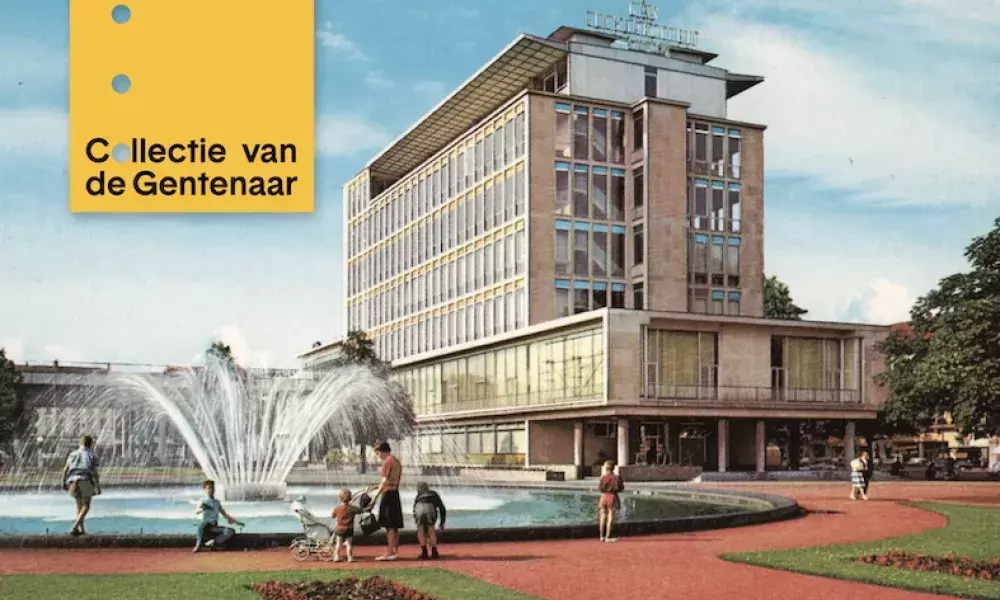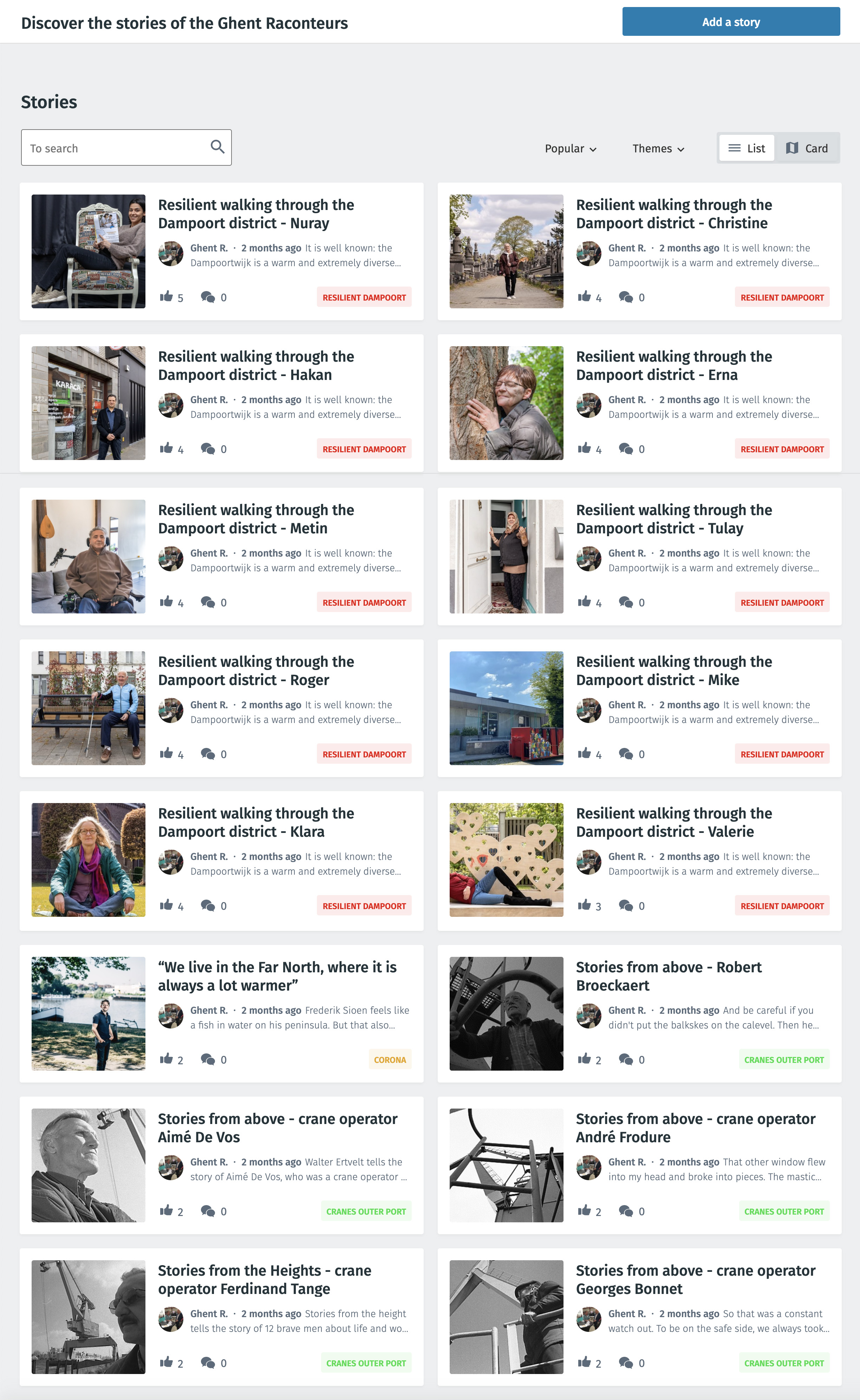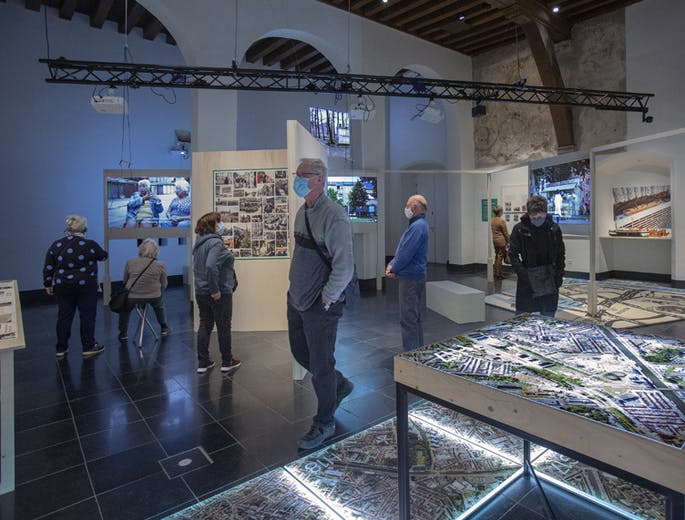
“I see many and rich ingredients in this project, but I don’t see how the cake will look like at the end?”. This is the metaphor, slightly provocative, summarizing the questions asked to the series of partners of the CoGhent project. To jump into such an articulated and complex project as CoGhent, the idea was to listen to a first range of varied key-players and confront their respective visions on what should be expected from the project.
CoGhent stands for Collections of Ghent and is one of the 4 projects selected in the “Culture and cultural heritage” category within Urban Innovative Actions’ 5th Call for Proposals. As we can read from UIA CoGhent webpage, challenged addressed by the project are described as two-folds. On the one hand “cities digitizing their cultural collections often lack the tools to use it to engage citizens. Data are stuck within institutional silos or used on single-purpose digital platforms that do not reach out to new audiences because they lack an open infrastructure”. On the other hand, “citizens have few means to contribute to and participate in the creation of our digital cultural heritage. However, culture is essential to improve social cohesion and citizens’ sense of belonging. Therefore, this project aims to contribute to the transition of cultural heritage institutions into places of community sense making”.
CoGhent is rich project first because it intends to face multiple classically challenging bridges such as between cultural heritage preservation and open digital access, between data availability and effective usage of applications, between institutions’ top-down management and citizens participative governance, between access to culture and social inclusion, etc. Consequently, CoGhent is also an ambitious project in terms of large stakeholder involvement. Not less than 7 different city administration services are collaborating including City Management, Policy Participations, Data and information, Social cohesion and Culture. 3 major city cultural institutions (AGB Art and Design; AGB Heritage; Digipolis) are partnering with Ghent University and 6 cultural creative private companies and NGOs (VIAA; iDrops; Studio Dott; Inuits; Fisheye; Chase Creative). Wondelgem, Sluizeken-Tolhuis-Ham, Watersportbaan-Ekkergem, 3 neighbourhoods of Ghent will take part in the project pilot anticipating the expected participation of all layers of the city population. Actually, nearly all the city should be involved in CoGhent and beyond, making Ghent a forerunner for redesigning cultural institutions engagement with citizens in Europe.
The Covid locked down everyone and the CoGhent project started and run for its first year online. It did not impact too much the project plan so far as field activities were only scheduled to start mid-2021 still creating a somewhat unusual posture for collaboration. “It’s the first time we met physically with Olivier Van D’huynslager from AGB Art and Design and Pieter Jan Pauwels, from District09, the 2 CoGhents’ fathers!”said Line Ostyn mid-May 2021, 10 months after she started coordinating the project. Whereas CoGhent is foreseen as a large melting pot bridging across social groups, professional competences and administrative silos, the sanitary measures left a bit project partners in their own institutional contexts. This first article proposed to play a bit on this situation and investigate how their respective visions underpinning CoGhent evolved in confinement, if they progressively match through online intense collaboration, or still diverge and to listen to what is emerging, what is the “cake” that all these rich ingredients will make? Also constrained by sanitary measures, the article is based on a series of 7 in-depth interviews of various CoGhent partners chosen for representing a sample of the project stakeholders’ variety.
CAPTURING AND LISTENING UNTOLD STORIES
“We want to bring the history that is in the museum in the neighbourhoods and reverse” states Neslihan Dogan, one of the so-called “district scout” in charge of exploring the 3 pilot neighbourhoods looking for local stories and bridges with city museums. CoGhent objective to develop digital tools to capture citizen stories and insights and feeds city-broad digital cultural heritage doesn’t fall into the “saving all the past” syndrome of our contemporary societies triggered by the acceleration of change driven by technology. The intention is rather voicing non-listen voices: “The history of below is prompt to disappear” states Neslihan Dogan. “CoGhent has nothing to do with ‘archive obsession’ and ‘increasing quantity of social media’ adds Bastiaan Baccarne, research group for Media, Innovation and Communication Technologies at Ghent University, it is focusing on the local history of the neighbourhood”

The Ghent Raconteurs is an initiative of Ghent Policy Participation Unit, collecting and displaying citizens’ original stories (photo credit: City of Ghent)
Active collection of vernacular stories is part of the last 2 decades increasing focus on social innovation and participative governance: capturing bottom-up knowledge, local storytelling, etc. is seen as a potential resource to help tackling societal challenges, giving visibility to resilient lifestyles, sharing daily sustainable practices, illustrating the richness of socio-diversity, or supporting the living together of heterogeneous communities in cities. Ghent, well known in Europe for its policy participation’s culture, develop CoGhent project on some successful experiences of capturing stories from “unusual suspects”. Tomas De Preter, lead for CoGhent partner Studio Dott design consultancy, points in particular “The Ghent Raconteurs”. This initiative from the city is collecting and displaying on its Policy Participation Platform “fascinating testimonies and stories showing how do the people of Ghent experience their neighbourhood and city and its evolution [...] it gives a voice and a face based on human testimonies and personal stories. [...] residents of Ghent who like to conduct interviews themselves, write stories, take photographs or have a passion for audio or video”5. In the same mood as The Ghent Raconteurs, CoGhent will organise the collection and restitution of stories at the city scale.
The Ghent Raconteurs is a stimulating initiative of putting forward citizens as local storytellers. For Tomas De Preter, CoGhent should go beyond “exposing the stories on a blog, to come a bit closer to the citizens”. The challenge for Bastiaan Baccarne is: “How can we give back the stories to the neighbourhood?”. Bastiaan Baccarne mentions “The Square Kilometer” heritage project at STAM Ghent museum of the city as an interesting answer to build upon.

The square kilometre Neuseplein and Brugse Poort, a ongoing exhibition at STAMsquare Ghent city museum focusing successively the local history and daily living of each of the city neighbourhood (photo credit: City of Ghent)
Since 2010, the STAM welcome visitors with a huge aerial view of the city: “Each tile of the aerial image corresponds to one square kilometre in real life. The museum is bringing out the hidden stories of the city tile by tile under the name 'The square kilometre', together with a local story collector who involves residents”6.
“I see the CoGhent project as a beginning. Museum should do more outreaching work, go in the neighbourhood. People carry history!” stresses Neslihan Dogan. In order to do so, CoGhent will deploy “a high-tech mobile experience room that will traverse three neighbourhoods. Within this space, the local citizen will enjoy a broad view of the cultural heritage in Ghent. Moreover, visitors will also be able to choose to participate by adding personal stories to enrich the shared cultural heritage of Ghent.”1
INCLUSION THROUGH CULTURE?
Putting forward people stories is an ambivalent issue leading to the best: mutual understanding of cultural differences, curiosity between communities, empathy, etc. It may also lead to the worst feeding the wind of communitarism, localism and populist political cultures blowing across Europe.
“CoGhent is looking at unserved audiences in neighbourhood, says Bastiaan, and aims at opening cultural barriers”. For Sami Souguir, Deputy Mayor for Culture, Urban Development and Spatial Planning in Ghent: “The project's driving force is social cohesion and participation: ‘everyone has a place’. CoGhent should bring mutual understanding through the diffusion of local popular history”. For instance, last year, explains Sami Souguir an exhibition focused the history of the textile industry in the city. It explained the raisons for immigration from north Africa, how this supported the local economy but also the town planning inherited from this period. In Ledeberg neighbourhood, for example, the factories also built the workers' houses, which explains the concentration of the population, etc.”. CoGhent intends fighting communitarism through a better understanding of collective histories. “Schools have classroom with children from hyper diverse origins, adds Neslihan Dogan, but it is nether talked how all these populations arrive, how Belgium wanted them to come. Local stories are giving voice to what happen”. And for Tomas De Preter: “If I know my neighbourhood was created to host poor migrant workers, I can understand why its streets are so small […] If people understand the broader context, then they can better live with it!”.
Raising various points of views, even through empathic storytelling is likely to also create divergences and tensions. For Tomas De Preter, “making these tensions visible will trigger discussion” and the need for moderation. The choice of which stories should be put forward and which not for instance will be key for social inclusion and cultural justice.
First discussions with CoGhent stakeholders emphasize the common history shared by all Ghent citizens, stressed the social vision of the project fostering inclusion and social justice through more equity in front of cultural heritage. In order to achieve these goals, CoGhent counts on the potential of digitalization, to open-up cultural heritage, make cultural data available to and reusable by all citizens. The project “will conduct user-research to gain insight into cultural needs, thresholds, and opportunities regarding digitised cultural heritage in order to figure out which data to open up and how to bring it all together”1
A BRICK IN A LARGER STRATEGY
More projects in the city compete as candidate to apply to UIA funding. Why did the city choose CoGhent among them? For Sami Souguir, "CoGhent has made the difference for a better mix of culture, technology and participation [...] The city of Ghent is a candidate for European Capital of Culture in 2030. CoGhent is a step to reach it. Youth Capital in 2024 will be another step. The project strengthens social cohesion and also serves the ambition of a Ghent to become a Climate-neutral City. It is also in line with the candidature to become Capital of Technology. […] We in Ghent are candidates for many things, there is a strengthening between all these different participations”
“CoGhent is also a good strategy to push an integrated policy across administration silos […] 7 city Services taking part, 7 different influences that will strengthen each other, add Sami Souguir, at least, I hope so!”
MANY CAKES IN A LARGE MEAL!
Coming back to the initial trigger of the article: “I see many and rich ingredients, but I don’t see how the cake will look like?”, what did we learn from these discussions with some CoGhent partners?
“I thank that it’s not one cake but many!” states Neslihan Dogan. A complex project such as CoGhent does not seek a single answer that would satisfy all questions raised. The listening to all citizens, the mutual understanding for more inclusion, the renewal and opening up of museums, the multiplicity and diversity of actors, etc. will lead to not one but several outputs which will have to be coherent.
There is no clear vision of what these cakes will be and how they will be made. "It's a bit early to say what's going to happen, says Sami Souguir. As it's a bottom-up operation we don't want to take the lead in a top-down way by saying what's going to happen!”. This apparent lack of vision is seen as a quality, a guarantee of the project's openness.
And finally, CoGhent should not only be seen as a series of isolated cakes. They are part of a complete meal, a strategy articulating the participation to different European projects, awards and distinctions bouncing off each other to strengthen the city leadership.
About this resource
The Urban Innovative Actions (UIA) is a European Union initiative that provided funding to urban areas across Europe to test new and unproven solutions to urban challenges. The initiative had a total ERDF budget of €372 million for 2014-2020.
Similar content




